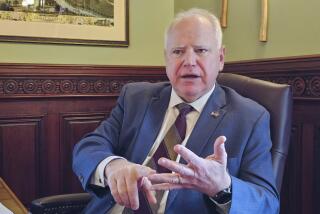Let’s Shoot for Quality Teachers, Not for Mars
- Share via
In 1609, the German astronomer Johannes Kepler completed a story that is often considered the earliest work of science fiction. Titled “Somnium,” or “Dream,” Kepler’s charmingly bizarre tale describes a trip to the moon by a young Icelander named Duracotus and his mother, Fiolxhilde, a lady who dabbles in magic and communes with spirits. It is one of these beings who transports the pair to our celestial neighbor by sheer force of its will. But if the journey smacks of the supernatural, the moon itself, on their arrival, is very much within the natural order. Indeed, the purpose of Kepler’s tale was to describe the lunar orb as a real physical world governed by empirical laws of science.
Until this time, the celestial bodies were not generally believed to be actual physical worlds, but nebulous balls of ether. In 1609, Kepler’s acquaintance, Galileo, pointed one of the newfangled “telescopes” at the stars and discovered to his surprise that the moon had mountains, suggesting it was made of the same crude matter as the Earth.
Kepler embraced Galileo’s discovery and took the idea further still by setting out in “Somnium” imagined details of lunar geography and speculations about the kinds of creatures that might inhabit this alien world.
“In general,” his narrator says, “the serpentine nature is predominant.” About 3 1/2 centuries after Kepler’s dream, humans finally traveled to the moon, and today proponents of space travel are itching to extend our reach to the other planets as well.
In February, a delegation from the Pasadena-based Planetary Society delivered a presentation to members of Congress titled “Mars: a New World for Humankind.” In making its pitch for an all-out effort to explore the Red Planet, the society was hoping to push along the agenda set last year by President Bush when he promised a manned return to the moon by 2015, if possible, and 2020 at the latest. Even more ambitiously, the president declared that the moon would become our staging post for manned missions to Mars.
But trips off-planet do not come cheap. The cost of a manned Mars mission has been conservatively estimated at $100 billion, though seasoned observers believe it will be many times that figure.
Hundreds of billions are hard to justify in any economic climate, let alone the current one, but Bush has a ready answer. “The fascination generated by further exploration” of the moon and Mars, he said last year, “will inspire our young people to study math and science and engineering and create a new generation of innovators and pioneers.”
It’s an appealing idea. Much of American wealth and power has been built on the back of its scientific and technological innovators, so inspiring a new generation is surely a worthy goal.
But it takes more than inspiration to make a new generation of scientists. It also takes instruction. Kepler’s fictional protagonist Duracotus was no mere dreamer but a seriously trained scientist. In the story, as a teenage boy he studies under Tycho Brahe, the real-life Danish astronomer whose meticulous observations of Mars were used by Kepler to discover the laws of planetary motion -- themselves a foundation for Newton’s discovery of the law of gravity.
As both Kepler and his fictional proxy understood, the heavens can be comprehended -- and ultimately accessed -- only by properly prepared minds. Reverie unsupported by pedagogy is mere fantasy.
If we really want to inspire our kids “to study math and science and engineering,” as the president proposes, by far the most effective means would be to ensure that they have good math and science teachers.
Looking to the future, the National Science Foundation has identified the shortage of qualified teachers as a major bottleneck in the nation’s science and technology infrastructure. According to a 2003 report by the Council of Chief State School Officers, nearly one-third of math and science teachers are over the age of 50. During the next decade, most of them will retire.
Who will fill the gap when they are gone?
Many states report having few high school science teachers under 30. New teacher recruits earn just $29,000 -- significantly less than the starting salaries for most other college graduates.
So here’s a suggestion: Let’s take that $100 billion proposed for the moon and Mars missions and spend it on a decade of great science teaching.
Let’s make it worthwhile for young people to come into the profession. Let’s offer them a salary of $50,000 a year -- add in benefits and in-service training, and let’s say $100,000 per person per year.
At that rate, we could employ 100,000 math and science teachers for an entire decade. Think what inspiration an army of well-trained teachers could provide. A lot more, I’ll bet, than a few footprints on Mars.
And here’s the real beauty of the scheme: Mars isn’t going away. A decade hence it will still be there -- and maybe by then a new generation of innovators will have developed the technologies to get us to the Red Planet at a price we can actually afford.
More to Read
Sign up for Essential California
The most important California stories and recommendations in your inbox every morning.
You may occasionally receive promotional content from the Los Angeles Times.












